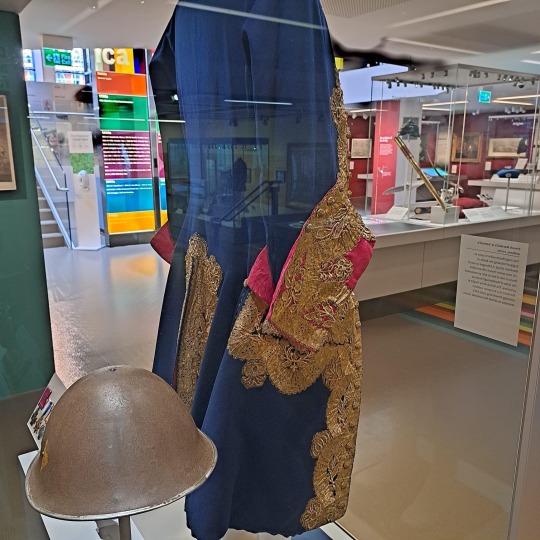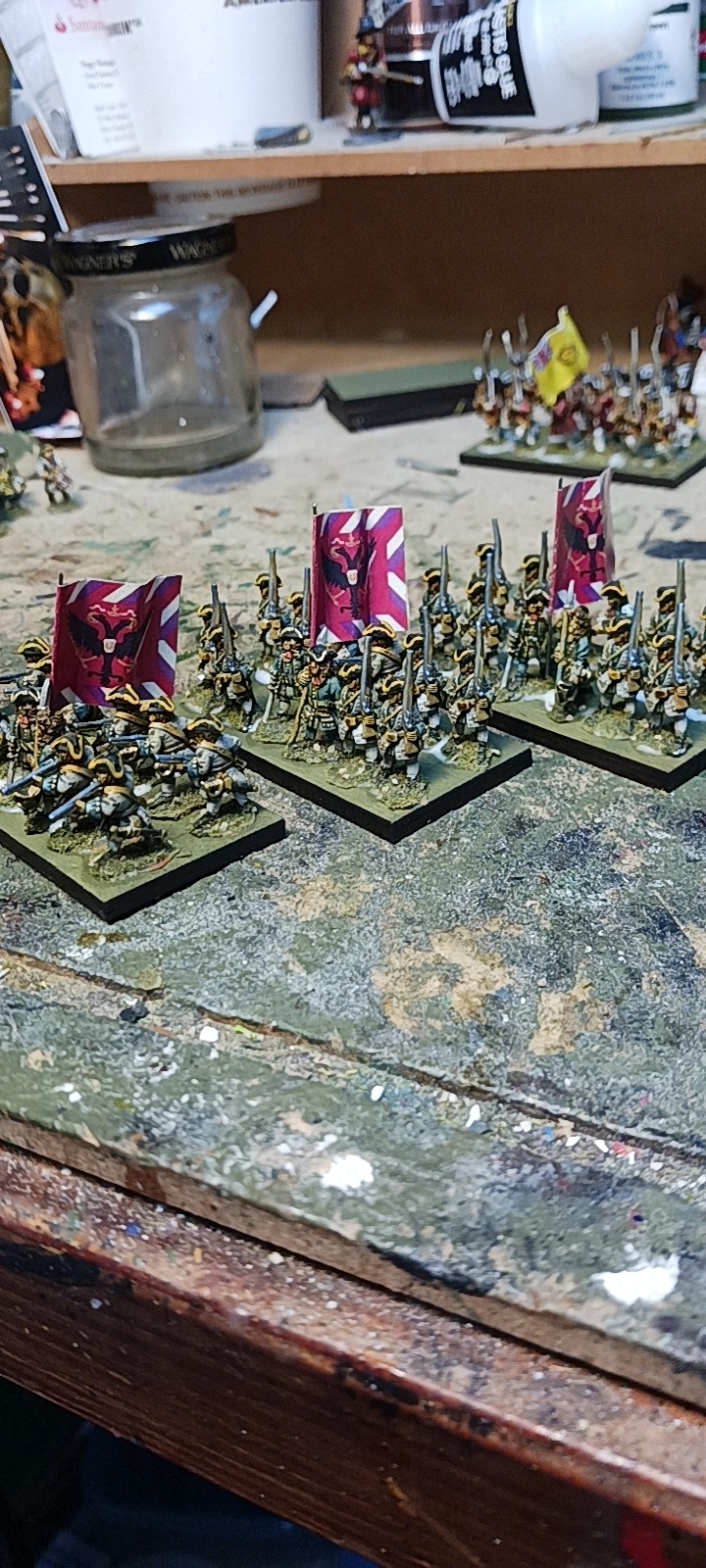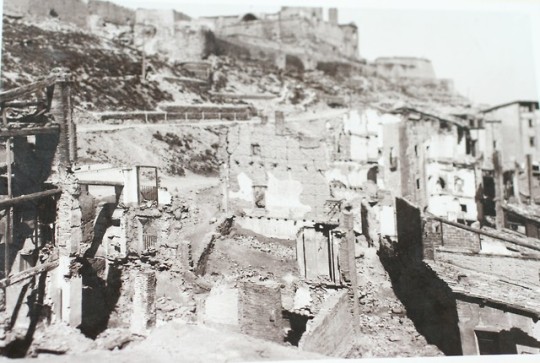#war of the spanish succession
Text



The uniform of a senior French general, captured at the battle of Blenheim in 1704 and now forming part of the exhibition at the National Army Museum.
#history#british army#french army#military history#18th century#battle of blenheim#blenheim#duke of marlborough#marlborough#war of the spanish succession#louis ix
157 notes
·
View notes
Text

#humor#history#barbie meme#barbie movie#18th century#1700s#war of the spanish succession#war of spanish succession#coses de la terra#history memes#world history#european history#barcelona#memes#funny
827 notes
·
View notes
Text
#napoleonic wars#100 years war#war of the Spanish succession#30 years war#all good times#shitpost#memes
6 notes
·
View notes
Text

Rebasing fun. Austrian regiment Alt-Starhemberg. 15mm Dixon miniatures painted in the 1990s getting a new purpose.
18 notes
·
View notes
Text


Leopold I and Eugene of Savoy walked so modern Nerd x Jock pairings could ru- *a hoard of historians rightfully and violently grab me and whisk me off their conference podium to the back where there are sickening gunshots and I am never heard of ever again*
((turn on audio you will regret))
#Sigh. Every single disclaimer i do not sh*p real ppl dead or alive etc etc this is a joke blah blah#Leopold i#Emperor leopold i#Eugene of savoy#17th century#Holy roman empire#Hre#austrian history#Battle of vienna#Siege of Vienna#war of the spanish succession#I could probably find something poetic about Eugene being rejected by Louis XIV for being ToO uGLy for the french army only to be taken in#By straight up the ugliest ruler on earth at that point n terrorising the continent tgt that iSNT THERE but i am a wr*ter such is my curse#Also yea probably not that nerd x jock dynamic to a T but like. It Sure Was Some Kind Of Dynamic#Something™ about quiet theatre kid Leopold constantly depicting himself as a military man ((like Eugene!)) & being super generous with him#And Known Gays ((whether it was true or not)) Eugene describing Leopold as a father figure like the mUTUAL ADORATION....... Pls 🤡 me n WHO#Btw re Eugene Queer i truly dk enough about him to say but what straight person signs off in a mix of 3 different languages lmao ((jk))
13 notes
·
View notes
Photo

Dutch troops led by the Prince of Orange assault the French left - Charles Rochussen
The Battle of Malplaquet took place on 11 September 1709 during the War of the Spanish Succession and was fought between a French army commanded by the Duke of Villars and a Grand Alliance force under the Duke of Marlborough. In one of the bloodiest battles of the 18th century, the Allies won a narrow victory but suffered heavy casualties, while the French were able to withdraw in good order.
At the start of 1709, the French state seemed on the verge of collapse, its treasury empty and food scarce while Allied advances in 1708 left the kingdom open to an invasion. These factors made the Allies overconfident and their excessive demands led to the collapse of peace talks in April. Villars had been instructed to avoid battle but after the capture of Tournai in early September, the Allies moved against Mons and Louis XIV of France ordered him to prevent its loss. Although the two armies made contact on 10 September, Marlborough delayed his attack until the next day, giving Villars the opportunity to strengthen his defensive positions.
When the battle began on 11 September, Marlborough used his standard tactic of simultaneous infantry attacks on the flanks, forcing Villars to move troops from the centre, which would then be broken by a mass cavalry charge. While successful in other battles, at Malplaquet the French were better led, held stronger positions and were highly motivated; as a result, the flank attacks incurred heavy casualties, particularly on the left where the Dutch lost over 5,000 men in less than thirty minutes and nearly 8,500 in all. Although the overall plan worked, the French cavalry ensured their centre did not collapse as on previous occasions, while the Allied infantry was too weakened by their losses to conduct a pursuit, allowing the French to withdraw intact.
The Allies lost over 20,000 men in the battle, the French at least 11,000, casualties which shocked contemporaries and heightened internal divisions within the Grand Alliance over the wisdom of continuing the war. It has been argued Malplaquet was a French strategic victory, since by saving his army and preventing an invasion of France, Villars ultimately enabled Louis to negotiate far better peace terms in 1713 than those available in 1709. While there is some truth to this, it did little to change the immediate strategic situation; Mons surrendered shortly afterward and the Allies resumed their advance in 1710. Some historians suggest the biggest impact of the battle was in restoring French military confidence after years of defeat.
#Battle of Malplaquet#War of the Spanish Succession#french history#european history#XVIII century#Charles Rochussen#XIX century#paintings#art#arte
2 notes
·
View notes
Text
CHRISTIAN DAVIES // SOLDIER
“She was an Irishwoman who joined the British Army in 1693 disguised as a man. She fought with the infantry in Flanders during the Nine Years War until 1697, then with the 4th Dragoons, later the 2nd Royal North British Dragoons and finally with the Scots Greys in the War of the Spanish Succession from 1701 to 1706. The author Daniel Defoe met her in old age when she was a Chelsea Pensioner and turned her story into a book entitled The Life and Adventures of Mrs. Christian Davies.”

0 notes
Text
1706 –Battle of Ramillies.



John Churchill, 1st Duke of Marlborough, defeats a French army under Marshal François de Neufville, duc de Villeroy at the Battle of Ramillies.
#May.23.1706#Battle of Ramillies#War of the Spanish Succession#John Churchill#1st Duke of Marlborough#history today
0 notes
Video
youtube
20221225 Mousquetaires Du Roi
Stages of work on the illustration. War of the Spanish Succession (1701-1714) Stages of creating an historisal illustration. Work in Progress. (Strelets)
#youtube#soldiers#history#War of the Spanish Succession#battle#cavalry#historical illustration#illustration#historycal#reconstruction#XVIII#war#military#strelets#WIP#Mousquetaires#Musketeers
1 note
·
View note
Text
Historically speaking, families that practiced incest, at least to a larger degree than other cultures, also gave women more rights. The reason the Habsburgs married niece-to-uncle all the time was because their inheritance customs dictated that property and titles could pass through the eldest daughter's line to her eldest son. So, in order to keep their empire in the hands of the Habsburgs instead of the French or the English, they married their daughters to Habsburg cousins. The one time this rule was not followed, it sparked a civil war where the Habsburgs were ousted from the Spanish throne because the Spanish king had not married his Habsburg daughter to another Habsburg. Ditto for the Egyptian dynasties where women generally had a larger say in political/cultural/domestic life than their European counterparts. Cleopatra was not the only female Pharoah to kick ass. All of this to say, the Valyrian Freehold and the Targaryens, by extension, most likely gave their women some stake in property rights and/or inheritance policies. Why else would it be traditional for Aegon to marry his oldest sister if custom dictated he only had to marry one? Why else would it even be a debate for Laenor to inherit the Iron Throne through his mother?
#asoiaf#worldbuilding#old valyria#house targaryen#habsburgs#cleopatra#ancient egypt#war for spanish succession#combined with the androgyny of valyrian#and the fact that women were dragonriders#paints a more gender equal society than Westeros
8 notes
·
View notes
Text
I finally asked my prof who his fav Habsburg is and he was SO delighted 😭 I told him I've been researching and he was like "on your own???" 🤭🤭
#my friend told me he'd be very pleased but like oof social anxiety yknow#but i finally was like fine ill do it#AND HE WAS SO HAPPY LOL#when i said charles vi he was like wow thats far back!#i think he said joseph ii was his? so cmon man my boy is only 2 generations back 😭#im not surprised if his is Joseph II considering he told us to watch Amadeus#but he was telling me some anecdote about a royal funeral#and was like pls come take Austria Civ#im going to be a maniac in that class >:)#very good though that he didnt ask *why* ive been researching 😭#'oh you know...historical rpf fic...'(and not even rpf in the way youd think LMAO)#but i mentioned the war of spanish succession hehehe#idk theres something really funny about saying Charles VI bcs hes the 6th! theres been 5 other Charles 😭😭#but im like hey do you remember this guy who's only importance was to be involved in this drama and was also the father of maria#yeah thats my guy#anyways i hope he now thinks of that when he thinks of me 😭#catie.rambling.txt
7 notes
·
View notes
Text

French assault columns storming the Dutch breastworks at the battle of Denain, 24 July 1712, by Giuseppe Rava. Love seeing historical artwork that shows a “big picture,” reminds me of the endless stick-men battle scenes I’d doodle as a kid (albeit this looks much better!).
91 notes
·
View notes
Photo

El Canyeret neighbourhood in the city of Lleida (capital city of Ponent, Catalonia) devastated after being bombed by Mussolini’s Italian fascist aviation, who was helping Franco and his fascist side in the Spanish Civil War.
Photo source: Arxiu Comarcal del Segrià.
Lleida was bombed many times by the fascist air-force in the Spanish Civil War, most heavily during the days known as “the Battle of Lleida”, between March 27th and April 3rd 1938, which ended in a victory of the fascist side. Lleida was not a big city nor very strategically important -the fascists’ aim was not factories or weapons, but civilians. Lleida’s importance was as a symbol: the rest of Catalonia still resisted as an antifascist stronghold, thanks to the militia organizations that many civilians had joined; but Lleida, as Catalonia’s Westernmost city (and thus the one closest to Spain where Franco’s army already controlled most territory), was the first city in Catalonia that was occupied by the fascist troops. (Remember that one of the main pillars of Spanish fascism are Catalanophobia and Spanish supremacy, and hatred of leftists and atheists, who were also identified with Catalonia because workers’ leftist movements were very strong here.)
The alliance between the Italian aviation, Franco’s Spanish troops and Moroccan troops occupied Lleida for the fascists, and most of the city’s population was either killed or fled as refugees to other parts of Catalonia still under control of the Republic. Out of the 38,000 inhabitants that the city had before the Battle of Lleida, less than 2,000 were left in the city on the day that the fascists considered they had bombed it enough and occupied it by land.
As soon as the fascists took control of the city, they went to erase the official registres of the victims of war, trying to erase responsibility for their massacre. They went to the Civil Registre to take the books of deaths, where the names and dates of the people who died in the city showed how many had been killed by the fascist bombs. The fascists always tried to obfuscate their crimes, they never had any honour even to face their own deeds.
By the way, the neighbourhood shown in the photo (El Canyeret) was home to the descendants of the families that Spanish troops had already destroyed 200 years ago. When Castilla (Spain) first occupied Catalonia, in the year 1714 as the end of the War of the Spanish Succession, the Spanish King Philip V militarized Catalonia, destroying whole neighbourhoods and even whole cities. In the main important cities, including Lleida, the Spanish government destroyed neighbourhoods and built military citadels on its place, that had the cannons always pointing at the population. In Lleida, people were expelled from the slopes of the Seu Vella hill, and the newly-homeless families built shanty towns further down. This was the creation of El Canyeret.
#lleida#catalunya#història#guerra civil#spanish civil war#history#1930s#1930s history#military history#1930s photography#20th century#european history#war history#spain#spanish history#revolutionary catalonia#war of the spanish succession#1714
21 notes
·
View notes
Text
Spain: Someone please pour me more wine.
Servant: Your wedding with Señor Francia starts in the next hour, my Lord...
Spain: More reasons to drink more wine.
#aph france#aph spain#aph#hetalia#frain#after The War of the Spanish Succession vibes#Spain dont choose marriage life THAT LIFE chooses him#pls ignore all of my silly headcanons#married in season 1 divorced in season 2 then remarried in idk what season
41 notes
·
View notes
Text
these kids not mentioning austria in their answers on the causes for the war of spanish succession....bud that's like 1/2 the reason the war began
#and the other 1/2? france c:#they keep mentioning england and the netherlands which yeah. important reasons there#but its called the war of the spanish succession for a reason. not one of those wars when the name tells you nothing#ponine keepin it real#like out of all the things to not mention this one is the headscratcher for me. how do we make this more obvious to more of you?
7 notes
·
View notes
Text
no offence to my succession mutuals but personally i can't wait for it to be over
#00#sorry but it looks like the more boring version of the hapsburg vs bourbons spanish war of succession
1 note
·
View note